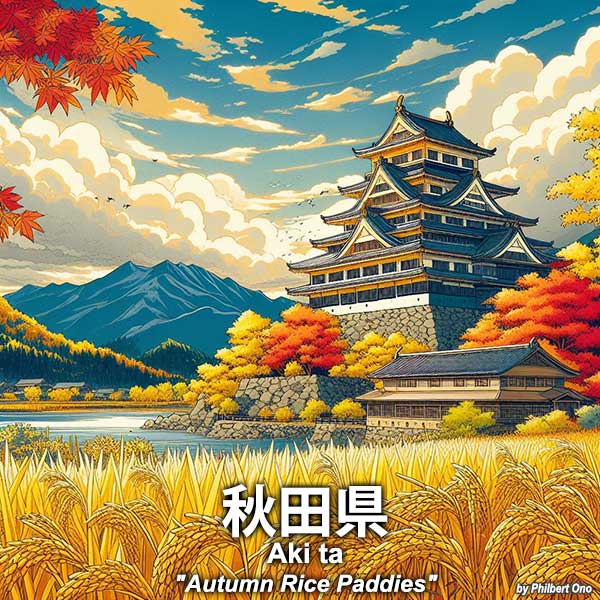AKITA – Autumn Rice Paddies 秋田県

Although “Akita” literally means Autumn Rice Paddies, this meaning is generally not recognized as the original since the current kanji characters are actually ateji characters selected for phonetic purposes and don’t have significant meaning related to the locality.
There are multiple theories:
Theory 1: “Akita” morphed from Agita (齶田) which was named by military commander Abe no Hirafu (阿倍比羅夫) in 658 when he visited the Japan Sea coastal region. Agita literally means “Jaw Rice Paddy.” It may have referred to the mouth of Omono River (雄物川) resembling a jaw in central Akita city. If you look at a map of the Omono River mouth, it does resemble a jaw.
Theory 2: The name came from Akuta (飽田) in reference to the low marshland around the mouth of Omono River.
Theory 3: It might have originated from the Ainu language word Aki-tai (あきたい) referring to a place where rice plants thrive.
Theory 4: Another theory says Agi might have originated from the word age (上げ), meaning to “raise up” in reference to the land that was built up to a higher elevation. The ta might have morphed from to (と) only to indicate the place.
Therefore, Akita (秋田) might actually mean “a place higher than the surrounding area” like a hill or plateau.
In central Akita city, Takashimizu Park (高清水公園) was the site of Akita Castle built in the 8th century. It is thought to be the area where land was elevated. Today, very little remains of Akita Castle, but an east gate and earthen wall have been reconstructed. There’s also the Akita City History Museum of Akita Fort Ruins (秋田城跡歴史資料館) exhibiting castle artifacts excavated from the site.
Image depicts an autumn scene with Akita Castle (more like a fort) on elevated land and rice crop turning yellow for harvesting.
Old province names: Ugo-no-Kuni (羽後国) (separated from Dewa-no-Kuni [出羽]) + Rikuchu-no-Kuni (陸中国) (separated from Mutsu-no-Kuni [陸奥国]).
*The AI-generated image is for illustrative purposes only and may not accurately depict any particular place in the prefecture.
*Major reference sources: Official prefectural website, Japanese Wikipedia, other websites.
Origin of other prefectural names (etymologies)
Overview | Aichi | Akita | Aomori | Chiba | Ehime | Fukui | Fukuoka | Fukushima | Gifu | Gunma | Hiroshima | Hokkaido | Hyogo | Ibaraki | Ishikawa | Iwate | Kagawa | Kagoshima | Kanagawa | Kochi | Kumamoto | Kyoto | Mie | Miyagi | Miyazaki | Nagano | Nagasaki | Nara | Niigata | Oita | Okayama | Okinawa | Osaka | Saga | Saitama | Shiga | Shimane | Shizuoka | Tochigi | Tokushima | Tokyo | Tottori | Toyama | Wakayama | Yamagata | Yamaguchi | Yamanashi